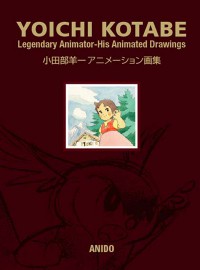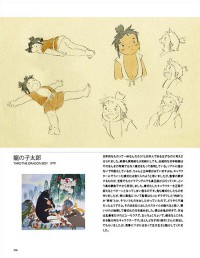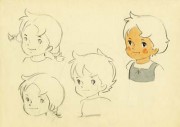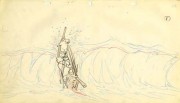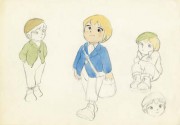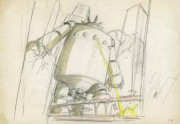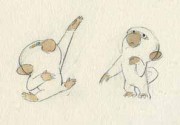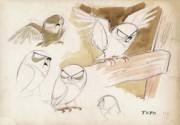小田部羊一アニメーション画集
2011. 01. 29
With Yasuo OTSUKA, Hayao MIYAZAKI, we have been fellows, aspiring to pursue animation expression and to create our own form of it. by Isao TAKAHATA
Yoichi Kotabe:Legendary Animator – His Animated Drawings
Author : Yoichi KOTABE/Executive Editor : Takashi NAMIKI
The most gorgeous book in the history of ANIDO FILM has come! This book must be the gift for all animators, directors and big fans of animation!
The works of YOICHI KOTABE, a genius animator and animation director, who is also the best friend of Hayao Miyazaki and Isao Takahata in Studio GHIBLI.
[Yoichi KOTABE’s profile is here]
YOICHI KOTABE has long career over 50 years. In these years, he has been the top animator, and created many famous characters such as HEIDI for “HEIDI THE GIRL OF ALPS”, MARCO for “FROM THE APENNINES TO THE ANDES”, etc.
Author : Yoichi KOTABE
Executive Editor : Takashi NAMIKI
Foreword : Isao TAKAHATA
Supervisor : Reiko OKUYAMA
First Edition : August 1, 2008
■SIZE:W230×H297
■300P(4C×240P/1C×60P)
■Hardcover with cloth
■With special acrylic resin case
■Language : JAPANESE except below with ENGLISH;
Introducition by Yoichi Kotabe
Foreword-”Our fellow, Yoichi Kotabe” by Isao Takahata
The titles of his works
Biographical Notes
もりやすじ画集
2011. 01. 28
This animation and illustration arts book tells us the real value of great maestro!
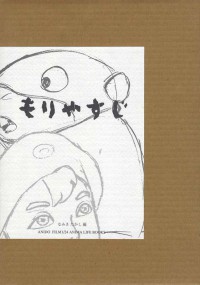 Author : Yasuji MORI <Biography>
Author : Yasuji MORI <Biography>
Executive Editor : Takashi NAMIKI
Foreword : Norio HIKONE
First Edition : September 1993
A man called “A GOD OF JAPANESE ANIMATION”!!
Yasuji MORI was master animator of Yasuo OTSUKA for “Lupin the Third”, Yoichi KOTABE for “HEIDI” “MARCO”, and Hayao MIYAZAKI well known to all over the world for “Princess Mononoke” “Spirited Away” and so on.
Contents :
The first half introduced THE PICTURES FOR CHILDREN’S MAGAZINE. “Itazura Pipo (naughty PIPO)” from legendary magazine “Manga-Shonen (Manga- Boys)”, THE COVER ILLUSTRATIONS of the monthly magazine FOR NURSERY SCHOOL TEACHERS, and THE DESIGN ARTS FOR THE PLAY, etc….
The second half of this book was made up of MANY DRAWINGS FOR ANIMATION WORK. Mainly the works drawn when he had belonged to TOEI ANIMATION STUDIO, like “HAKUJADEN(The White Snake Enchantress)”, “WANPAKU OJI NO OROCHI TAIJI(Little Prince and the Eight-headed Dragon)”, “TAIYO NO OJI HORUSU NO DAIBOKEN (Little Norse Prince Valiant)” and “NAGAGUTSU WO HAITA NEKO(Puss’N Boots)”.
Besides, THE COLOR IMAGE BODES of “ALIBABA and 40 Thieves”, “Holy Nights of Animals” -which were only planning and not produced – were shown for the first time. There are also many HIS DRAWINGS, SKETCHES FOR THE PLANNING OF TV SERIES after he got freelance.
The end of the book, you can know about his background with many photos.
■SIZE:A4 (H297×W210mm)
■248 pages
■Hardcover with special box
■Language : JAPANESE, ENGLISH
[Yasuji MORI's profile is here]
椋尾篁アニメーション美術画集
2011. 01. 27
Takamura Mukuo, a legendary background artist for animation —— who described light, shadow, and any textures of objects like composing a poetry…
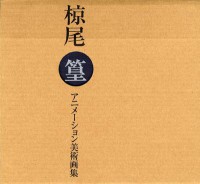 Author : Takamura MUKUO
Author : Takamura MUKUO
Executive Editor : Takashi NAMIKI
Foreword : Taro RIN, Isao TAKAHATA
Supervisor : Keiko MUKUO, Tadao KUBOTA(Mukuo Studio)
[Takamura MUKUO's profile is here]
All the works of Takamura Mukuo, who animated and created the world of a lot of masterpieces such as “Galaxy Express 999″, “From the Apennines to the Andes”, “Genma-Taisen(Harmagedon)”, “Goshu, the Cellist”, “Sailor Moon”, and so on…
This book is full of his background art, image board, and plans.
Besides the above titles, “The Sword of KAMUI”,”Ganbare Genki”, “Three Kingdoms”, “The Command to Stop the Construction” also appeared on this gougeous book.
■SIZE:B4 wide (255×284mm)
■160P
■Hardcover
■with special box
■Language : JAPANESE(Text is a little included)
First Edition : April 2004
(日本語) 宇田川さんにインタビュー
2011. 01. 26
Sorry, this entry is only available in 日本語.
もぐらノート〜もりやすじ画集2〜
2011. 01. 26
Yasuji Mori, one of the greatest Japanese animator was also the great illustrator. This illustration art book tells us the real value of the great maestro!
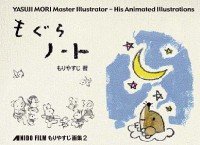 Yasuji Mori2: Master Animator – His Animated Illustrations
Yasuji Mori2: Master Animator – His Animated Illustrations
This book published as the second version book of Mori’s art works collection, mainly included his illustration appeared on the magazine such as “a Little Child and Preschool Education” “Mommy”, or the children’s book such as “Cinderella” “Thumbelina” “Snow White” “Peter Pan” and other Japanese folk tales.
You can enjoy over 400 pieces of illustration with a lot of color pages (about half of the book)!
His essay on the Disney and Ghibli works, or the other his fellow animators was also included. (Japanese only)
Author: Yasuji MORI
Executive Editor: Takashi NAMIKI
Foreword: Isao TAKAHATA
First Edition : February 2006
[Yasuji MORI’s profile is here]
■SIZE:A4 (H210×W297mm)
■160P
■Hardcover
■Language : JAPANESE(Text is a little included)
For the anniversary of publishing, we produced T-shirt, Post cards set, Memo Pad, Bag and calender.
写真集 Animated People in PHOTO〜世界のアニメ作家たち〜
2011. 01. 25
Genuine portraits of “Animated People” from All Over The World!
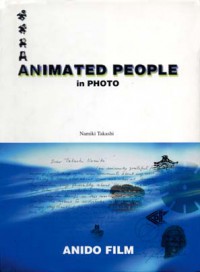 TAKASHI NAMIKI : ANIMATED PEOPLE in PHOTO
TAKASHI NAMIKI : ANIMATED PEOPLE in PHOTO
Author & Editor : Takashi NAMIKI
All Photo by Takashi NAMIKI
Illustration : Masahiro KATAYAMA
This book is a photographic chronicle of friendship between the author and the “animated people” animators, directors, historian, producers, staffs of animation festival, and whoever concern with animation job. The author and the photographer Takashi Namiki is animation historian besides a producer, who respects those people very much.
First Edition : June 2000
size: A5 (H21mm~W148mm) 112P
Hardcover
94 photos are all monochrome
Language : The captions of photos : English/The object’s profile : Japanese
[Takashi NAMIKI's profile]
Contents(People in the book):
Alexandre Alexeieff / Aleksandra Korejw / Alexandre Petrov / Barbel Neubauer / Barry.J.C.Purves / Bernard Palacios / Bob Godfrey / Bob Kurtz / Bob Stenhouse / Borivoj Dovnikovic / Bretislav Pojar / Brothers Quay / Bruno Edera / Bruno Bozzetto / Caroline Leaf / Charles Solomon / Chuck Jones / Csaba Varga / Dingxian Yan / Edit Bleier / Edoward Herscovitz / Eva M.Toth / Fedor Khitruk / Ferenc Mikulas / Frank R.Thomas / Frederic Back / Fusako Yusaki / Garry Bardin / Georges Schwizgebel / Giannalberto Bendazzi / Gizella Neuberger / Igor Kovalyov / Ishu Patel / Jan Svankmajer/ Jacques Drouin / Jean-Luc Xiberras / Jean-Francois Laguionie / Jimmy Teru Murakami / Jiri Barta / Joan C.Gratz / John Halas / Josko Marusic / Jozsef Gemes / Karel Zeman /
Les Drew / Marcos Magalhaes / Marec Fritzinger / Maria Horvath / Mark Davis / Mark Baker / Michaela Pavlatova / Michel Ocelot / Myron Waldman / Nick Park / Nicole Salomon / Paul Grimault / Paul Driessen / Pavel Prochazka / Pavel Koutsky / Peter Szoboszlay / Prit Parn / Raoul Servais / Ray Harryhausen / Renya Onasick / Shuchen Wang / Veronique Steeno / Vlasta Pospisilova / Ward Kimball / Wei Te / Wendy Tilby / Will Vinton / Yuri Norshtein / Zoltan Varga Szilagyi
Kazuko Komatsubara / Takamura Mukuo / Hayao Miyazaki / Osamu Tezuka / Kihachiro Kawamoto / Yoji Kuri/ Yoichi Kotabe / Yasuo Otsuka / Tadanari Okamoto / Yasuji Mori / Isao Takahata / Norio Hikone / Taku Furukawa/ Fusako Yusaki / Syo Yoshimura/ Ryotaro Kuwata / Goro Sugimoto / Tadahito Mochinaga/ Shinichi Suzuki / Seiichi Hayashi / Kazuhide Tomonaga/ Yoshinori Kanada / Kenzo Masaoka / Masao Kumagawa
Yasuji MORI
2011. 01. 23
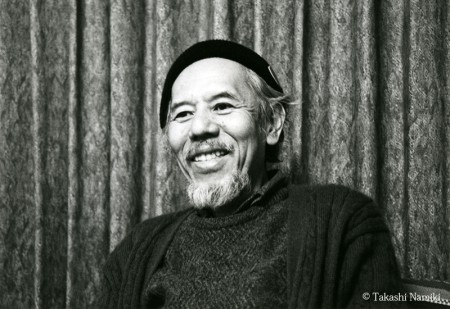 Photo:Takashi Namiki
Photo:Takashi Namiki
A man who is called “The God of Japanese Animation”
Born on 28 January, 1925 in Tottori, Japan, Yasuji Mori grew up in Taiwan.
In 1948 he graduated from the National University of Fine Arts in Tokyo, having
studied architecture.
He saw an American animated shorts, however, and decided to become an animatorinstead. He joined Nippon Doga, where he met Kenzo Masaoka and Sanae Yamamoto,pioneers of the Japanese animation. Having done inking for “Torachan to Hanayome / Trachan and the Bride,”he begin animating for the shorts, “PoppoyasanNonki Ekicho / The Carefree Stationmatster,” followed by “Kobito to Aomushi /The Little Man and a Catarpillar,” under the instruction of Masao Kumagawa andHideo Furusawa.
As the company underwent a period of restructuring, Mori moved to Seibu depart-ment store where he designed posters for publicity; he also began illustratingfor the monthly magazine, Manga Shonen, as well as recieving commissions from other prestigious publishers like Shogakkan and Kodansha, starting a lifelong career in children’s literature illustration.
Mori returned to animation to co-direct “Kousagi Monogaari / The Story of Little Rabbit” with Taiji Yabushita and rejoined Nichido Eiga-sha(formarly Nippon Doga) in 1955. For “Kuroi Kikori to Shiroi Kikori / The Black Woodcutter and the White Woodcutter” he was responsible for screen-adaptation, character design and key animation. When Nichido Eiga-sha came under the auspices of the Toei Group to become Toei Animation Studio in 1956, Mori was at the forefront ofthe animation production division, a position he continued to dominate ever since, within the environment of rapidly growing industry.
At Toei, Mori contributed greatly to the growth of the studio which became the largest in Asia, with such films as “Hakujaden / The White Snake Enchantress / Panda and the Magic Serpent,” the first animated feature in color to be made in Asia, “Shonen Satutobi Sasuke / The Adventures of Little Samurai Magic Boy” and “Saiyuki / Alakazan the Great.” With “Wanpakuooji no Orochitaiji / Little Prince and the Eight-headed Dragon” in particular, Mori created what may be called an uniquely Japanese animation art – by unifying the look of the whole film with a style quite unlike anything that had been seen previously. Also, while working on such features as “Taiyo no Ooji Horusu no Daiboken / Little Norse Prince Valiant” and “Nagagutsu o Haita Neko / Puss’N Boots,” and on shch shorts as “Koneko no Rakugaki / Kitten’s Scribbling” and “Koneko no Sutajio / Kitten’s Studio,” Mori nurtured the talent of those animators who went on to build notable careers of their own – Hayao Miyazaki, Yusaku Sakamoto, Yasuo Otsuka,Norio Hikone, Reiko Okuyama, Isao Takahata, Sadao Tsukioka, Kazuko Nakamura, Makoto Nagasawa, Seiichi Hayashi, Gisaburo Sugii, Yoichi Kotabe, etc…
After moving to Nippon Animation in 1973, Mori worked extensively for television – desining characters and directing animation for “Yamanezumi Rokkiy Chakku / Rocky Chuck,” drawing conceptual sketches as well as directing animation for “Arupusu no Shojo Haiji / Heidi,” “Furandasu no Inu / A Dog in Flanders,” “Kuma no Ko Jakkiy / Little Bear Jackie” etc. During that time, Mori continued to illustrate children’s books, such as “Folk Tales of the World” series for Kodansha and Popurasha, and the cover illustrations of the monthly magazine “Yoji to Hoiku / Infants and Nursing”. In “Fushigina Kaban / The Strange Bag” and “Hariemon no Kusuri wa Oishiika / Is Hariemon’s Medicine Tasty?” in paticular, he was showing the maturity of his talent before his death on 4 September, 1992.
His published works include “Yasuji Mori : Master Animater – His Animated Drawings(edited by Takashi Namiki / Anido Film 1993), “Mori Yasuji no sekai / The World of Yasuji Mori(edited by Hayao Miyazaki)”(Nibariki 1992).
